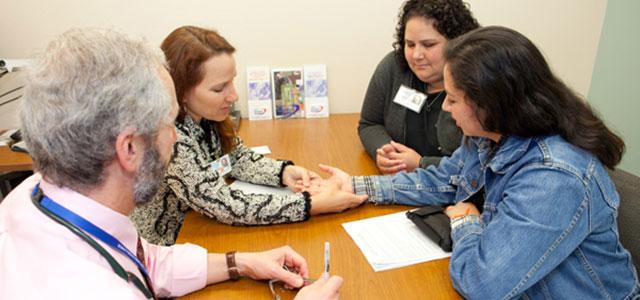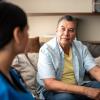
Members of the UCSF Madison Clinic for Pediatric Diabetes Saleh Adi and Colette O’Brien work with nursing student Dara Nunn to check on a patient with diabetes.
Educating Patients, Families and Students About Diabetes
Volunteer clinical faculty and preceptors offer students individual perspectives and hands-on experience in a variety of health care settings and specialties. The cumulative effect of what these volunteers impart plays a significant role in the care any health system delivers. This series aims to shed light on the unique roles these valuable mentors play.
This month, we hear from Colette O’Brien, a pediatric nurse practitioner at UCSF’s Madison Clinic for Pediatric Diabetes and assistant clinical professor in the School of Nursing’s Department of Family Health Care Nursing.
I have a bachelor’s degree in physical education from UC Berkeley, and I originally intended to go into physical therapy, but I decided that I wanted to be more involved with patients, so I completed an accelerated program at the University of San Francisco (USF) to get my bachelor’s degree in nursing. I knew when I first decided to become a nurse that I wanted to be a nurse practitioner, so after working for three years in intensive care and pediatrics, I went to the University of Illinois at Chicago for my master’s degree as a pediatric nurse practitioner (PNP).
I prefer to know a lot about a little rather than a little about a lot, so when I chose my clinical rotation in graduate school, I looked at different subspecialties, including asthma and cerebral palsy. My last rotation was in diabetes, and that was a good fit.
I worked at La Rabida Children’s Hospital in Chicago for two years, then moved back to the San Francisco Bay Area in 2002 and got a job with UC San Francisco’s Madison Clinic for Pediatric Diabetes. When I first started, I was the only nurse, so I took on the role of certified diabetes educator, in addition to working with researchers and doing clinical work. As the program has grown, I’ve worked as a PNP predominantly in the outpatient clinic, where I see patients from infants to age 26 with a wide variety of conditions, such as type 1 or type 2 diabetes, drug-induced diabetes or cystic fibrosis-related diabetes.
As a nurse practitioner, I look at the patient’s whole support system: I ask how things are going at school, how the family is doing, how the patient’s social life is going, because all of that can have an impact on their diabetes control. About 80 percent of my time is spent educating the family, and a lot of it is psychosocial. It’s interesting to work with families over the years, because as children grow and change, not only is their diabetes different, but their family structure and how they manage their diabetes both change. The patient takes on more responsibility, and part of my job becomes setting them up for success at that. I check to make sure everything is getting done or to provide support if they need more resources.
I work closely with our dietician and social worker and make a lot of referrals to our two psychologists. Diabetes is a huge stressor, and it can be even more challenging because most children with diabetes don’t look sick. But diabetes affects every moment of their day; they constantly have to navigate questions like: What am I going to be doing in an hour, and when am I going to eat? When am I going to check my blood sugar?
Everyone who works in the diabetes community is eager to educate people about the disease, so teaching other nurses is a natural fit. I give lectures about diabetes to NP students at UC San Francisco School of Nursing, and I’ve mentored students from USF and San Francisco State University, but most of my students are from UCSF. I usually take one second-year nurse practitioner student each quarter because I want to make sure I have the time and energy to give them the best experience. We usually start by doing patient visits together. I give them some history and talk about what I want to focus on for the visit. We see the patient and family, then we talk afterwards about what we did. The students also shadow the dietician and social worker, so they get an idea of multidisciplinary care.
After the first two weeks, if the student’s comfort level seems fine, I ask them to take histories, assess a patient’s progress and make recommendations. I try to do insulin pump starts with them because it’s education intensive, and we spend a lot of time with the families to make adjustments between visits. When patients with new-onset diabetes come into the clinic, it’s also a good opportunity for students to see how a family goes through the process of accepting or not accepting the diagnosis.
I try to make sure students understand that diabetes is a lifelong journey for our patients, and that one of the most important things is to be nonjudgmental. There is a lot of stigma associated with diabetes in today’s society. People with type 1 and type 2 diabetes have to defend themselves against the idea that they caused their disease. It can have a big impact on them, and it’s crucial that they know their providers are not judging them. We have to establish trust so that the patients feel comfortable being honest with us.
I’m very fortunate to be able to take these journeys with these families. Having worked in the clinic for 11 years, I’ve seen some of my patients grow into young adults, and that experience – of witnessing growth – is echoed in my teaching role. I see the students in the beginning when they don’t know about diabetes, and when they leave, they’re a lot more comfortable with it. Getting them to that place of understanding is very rewarding.



